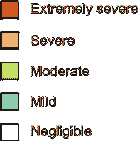
 |


This map was creatively adapted from "Cook, D. C., Van Orden, A. C., Reyes, J., Oh, S. J., Balasubramanian, R., Carpio, J. J., and Townsend, H. E., “Atmospheric Corrosion in Marine Environments along the Gulf of México,” Marine Corrosion in Tropical Environments, ASTM STP 1399, S. W. Dean, G. Hernandez-Duque Delgadillo, and J. B. Bushman, Eds., American Society for Testing and Materials, West Conshohocken, PA, 2000."
Air pollution in the large cities of Mexico is becoming a serious concern for both local and national governments. Mexico City, Guadalajara and Ciudad Juarez are the most polluted, with Mexico City's air quality being among the worst in the world. According to the World Health Organization (WHO), Mexico City's air averages 179 mg per cubic meter of suspended particulates, well above the WHO 90 mg maximum recommendation.
Exhaust fumes from Mexico City's 3 million cars (approximately) are the main source of air pollutants. Problems resulting from the high levels of exhaust are exacerbated by the fact that Mexico City is situated in a basin. The geography prevents winds from blowing away the pollution, trapping it above the city. Guadalajara, Mexico's second largest urban center, exceeds pollution limits 90% of the year, due largely to the large number of vehicles operating in the city. Ciudad Juarez, a border city of 1.4 million inhabitants, is home to many assembly plants ("maquiladoras") that are responsible for the release of dangerous substances into the environment.
Though automobiles still account for 90% of air pollution, industrial growth is also causing increased environmental damage to the area. Air pollution in northern Mexico also impacts U.S. border areas. The Mexican government has presented several innovative proposals for fighting air pollution, including incentives for using cleaner fuels and smog control measures. In major urban centers, private car drivers are required to have catalytic converters or refrain from driving one day a week. The pollution fighting measures put in place in the mid-1990s have already improved visibility and air quality in the city. Mexican environmental initiatives include developing clean taxis and small buses in order to reduce urban emissions; improving environmental infrastructure; and strengthening the northern border regions' environmental planning and administration.
Source: Energy Information Agency
Other regions and countries: Argentina, Brazil, Canada, Central America, Chile, China, Colombia, Cuba, France, Germany, India, Italy, Japan, Mexico, New Zealand, North America, Portugal, Russia, Saudi Arabia, South Africa, Spain, Sweden, UK, USA, Venezuela
 |
 |